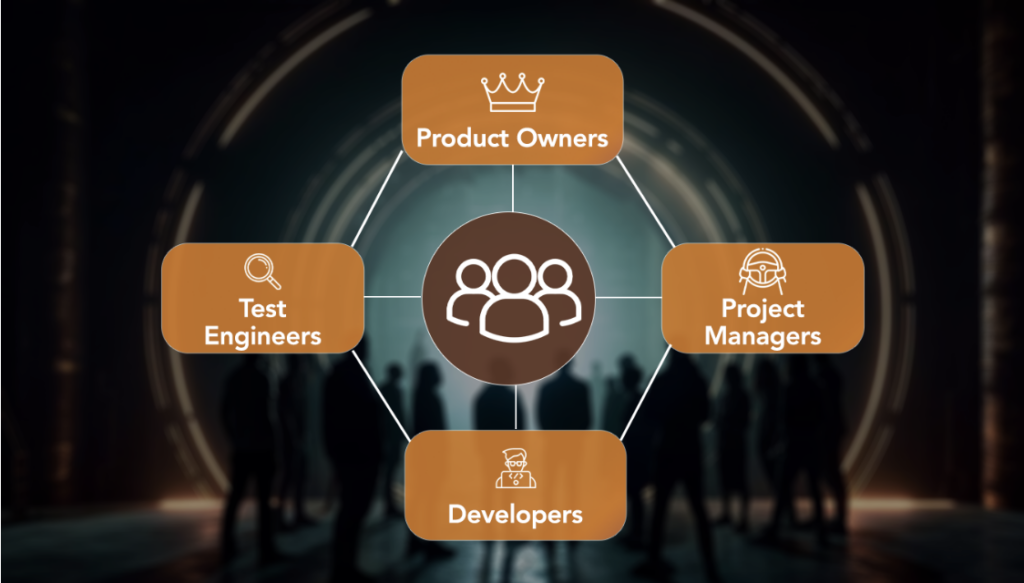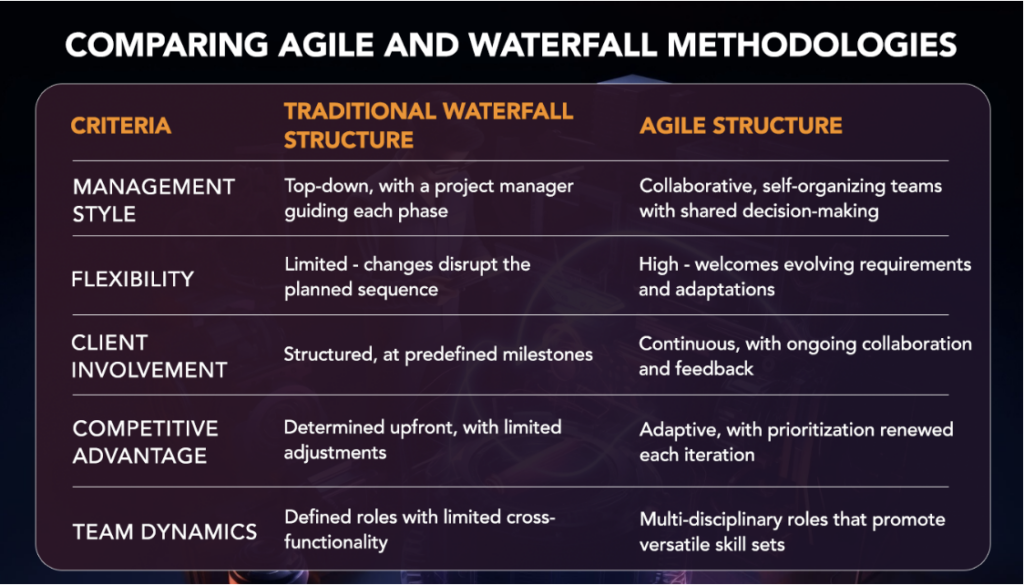Software Development Team: Structure, Roles, and Tips
 1 May 2024
1 May 2024? Listen to the Summary of this article in Audio
Navigating the complexities of software development team structure is essential for any project’s triumph. Comprising multidisciplinary expertise, these teams are the driving force in turning abstract ideas into robust software solutions. Success hinges not just on individual skill, but how effectively these skills are orchestrated within the team. The team’s architecture is shaped by diverse factors including the project’s breadth, its technical intricacies, time constraints, and budgetary ceilings. With stages varying from discovery to MVP development, each phase demands a bespoke constellation of competencies, encompassing software development team roles such as product owners, project managers, developers, and test engineers.
Embracing the right methodology is crucial for managing a software development team. Agile endorses a self-managed structure encouraging adaptability and iterative progress, while Waterfall offers a more controlled, step-wise progression. Typically, the likes of business analysts, software architects, UX/UI designers, and developers form the core of these teams, each role seamlessly connecting tech ambitions with business results. Hence, mastering the art of software development team management becomes a pivot for gear-turning efficiency and innovation within a development group.
Understanding how to manage a software development team begins with outlining clear roles, fostering collaboration, and ensuring financial allocation is suitably aligned with team requirements. Here, we unfold the strategic essence and best practices crucial for leading, organizing, and nurturing software development teams toward the pinnacle of their potential and beyond.

Key Takeaways
- Effective software development teams are tailored to the precise demands of the project scope and complexity.
- Selecting the appropriate software development methodology is pivotal to the team’s operational success.
- Defined roles within the team, such as business analysts and UX/UI designers, bridge the gap between business needs and technical execution.
- Agile and Waterfall methodologies influence the managerial tactics of a software development team.
- Leadership in software development requires a balance of strategic oversight and empowering team autonomy.
- Strategic collaboration and clear communication are the cornerstones of managing a software development team efficiently.
Introduction
Embarking on the journey of building a software development team demands a nuanced understanding of the methodologies that will be employed. The selection between an Agile software development team structure and a traditional software development team structure carries profound implications for the project’s lifecycle. It influences everything from ideation to delivery, touching upon the collaborational dynamics of the team and the efficiency of the workflows established. This pivotal decision echoes throughout the project, underscoring the importance of aligning the development process with the project’s goals and the team’s capabilities.
Understanding the Software Development Process
In exploring the underpinnings of software development, one encounters a spectrum of methodologies. Traditional models delineate a clear, step-by-step approach, encapsulated by the Waterfall methodology. This established framework lays out a series of defined, sequential phases, each resting on the completion of its predecessor, and is often characterized by its top-down management style. Here, change is anathema – it disrupts the tightly held sequence of operations.
In direct contrast stands the Agile model – a beacon of flexibility and adaptation. Rooted in the principle of iterative development, this approach invites client participation, champions feature prioritization, and thrives on cross-functional team collaborations that bleed across development stages. The Agile manifesto’s embrace of change and continuous feedback creates a lively environment where software solutions can evolve in real-time, tethered closely to client needs and market dynamics.
Choosing the right path is a deliberate process, with each option carrying distinct ramifications. To illustrate these differences, consider the contrasting outlines below:
| Criteria | Traditional Waterfall Structure | Agile Structure |
|---|---|---|
| Management Style | Top-down, with a project manager guiding each phase | Collaborative, self-organizing teams with shared decision-making |
| Flexibility | Limited – changes disrupt the planned sequence | High – welcomes evolving requirements and adaptations |
| Client Involvement | Structured, at predefined milestones | Continuous, with ongoing collaboration and feedback |
| Feature Prioritization | Determined upfront, with limited adjustments | Adaptive, with prioritization renewed each iteration |
| Team Dynamics | Defined roles with limited cross-functionality | Multi-disciplinary roles that promote versatile skill sets |
In the pursuit of constructing a well-oiled software development machine, one must carefully weigh these methodologies against the unique context of their project. This foundational step paves the way for the nuanced task of building a software development team – one that is robust enough to tackle the challenges ahead, agile enough to weave through the demands of today’s rapid innovation, and structured enough to deliver reliable, impactful software solutions.

Consult with our software architects to determine if Agile or Waterfall is best suited for your project needs.
The Structure of a Software Development Team
Delving into the fabric of a software development team, it’s clear that its foundation is layered with not just skills, but a symbiotic structure that encapsulates the roles and expectations at its core. The way a team is woven together can spell the difference between success and struggle, emphasizing the need for software development team management to be both adept and insightful. From fostering the strategic vision necessary in a team lead for software development to establishing a typical software development team structure, the edifice of a development team is nothing short of crucial for a project’s prosperity.
Typical Software Development Team Structure
A typical software development team exemplifies a diverse ecosystem of roles, each a cog in the vast machine of product development. The composition – whether it’s a business analyst who deciphers complex customer needs into actionable instructions, or a DevOps engineer deftly orchestrating code deployment – this coordinated team synergy is paramount. Roles are designated not merely by title, but by the unique value and expertise each member brings to the table, with a clear allocation of tasks and responsibilities that is indispensable in achieving the shared project objectives.
Agile Software Development Team Structure
Agile methodologies pivot on the tenet of flexibility, with structures that anticipate and embrace change. Unlike their traditional counterparts, Agile software development teams champion a flat hierarchy where roles meld fluidity with distinction. In such dynamic environments, the emphasis is placed on the team’s collective ability to adapt to evolving project requirements while maximally adding to customer value. Here, each member is a torchbearer of progress, committed not just to their individual output but to the progression of the team as a whole. This approach capitalizes on each individual’s insight, thus influencing the trajectory of the development process.
Agile teams are orchestrated to be self-governing; yet within this autonomy lies a well-defined structure. The roles and responsibilities of a team lead in such a software development framework are geared toward enabling rather than commanding, nurturing a climate where innovation sprouts from the very soil of cooperation and collective expertise. This perspective on team dynamics is integral for the stabilizing yet progressive Agile agenda, fulfilling the quest for an adept team structure while calibrating to the unique tempo and requirements of each project.
| Traditional Role | Typical Responsibilities | Agile Equivalent | Adaptive Responsibilities |
|---|---|---|---|
| Project Manager | Planning, task allocation, progress tracking | Scrum Master/Agile Coach | Facilitation, coaching, removing impediments |
| Business Analyst | Gathering requirements, documentation | Agile Business Analyst | Backlog refinement, stakeholder collaboration |
| Software Developer | Writing and testing code | Agile Software Developer | Collaborative coding, continuous integration |
| Quality Assurance | Sequential testing phases | Agile Tester | Continuous testing in a dynamic environment |
| UI/UX Designer | Crafting the user interface and experience | Agile Designer | User experience design within iterative sprints |
The typical software development team structure operates like a well-oiled machine, each part integral and every movement precise. Yet, an Agile structure is akin to an organism, evolving and growing with the demands of its environment. The roles, while reflective of traditional titles, are remodeled to nurture innovation, adaptability, and a relentless pursuit of customer-centric development, carrying forward the legacy of software craftsmanship into a new era of development.
Roles within a Software Development Team
The success of a software project is often determined by the members of a software development team and how well they fulfill their specific roles. A team’s effectiveness pivots on the clarity of its structure, from developers and designers to the leadership layer that orchestrates the project’s trajectory. As such, it’s crucial for organizations to understand the key roles and responsibilities within a team, whether they are hiring a new software development team or leading a software development team through the stages of growth and development.
Key Roles and Responsibilities
A vast array of roles comprise the software development process, each contributing uniquely to the project’s success. Business analysts lay the groundwork by converting complex business needs into clear-cut technical requirements. Software architects, on the other hand, take these requirements and conceive a structure that will house the future application or system. Let’s delve into a detailed tableau that classifies the major roles in a typical software development team:
| Role | Responsibilities |
|---|---|
| Business Analyst (BA) | Interfaces between the business stakeholders and development team to translate business needs into technical requirements. |
| Product Owner (PO) | Defines the product vision and manages the feature backlog, aligning product development with customer needs and company goals. |
| Project Manager (PM) | Coordinates project delivery, ensuring that timelines and budgets are adhered to while facilitating resources and communication. |
| UX/UI Designer | Focused on the end-user’s experience and interaction with the product, crafting interfaces that are not only visually appealing but intuitive to use. |
| Software Developer | Employs various programming languages and technologies to create efficient and scalable software applications. |
| Testing Engineer | Validates and verifies the application’s functionality through careful testing, ensuring reliability and adherence to requirements. |
| Software Architect | Designs the overall system structure, researches suitable technologies, and ensures compliance with technical standards. |
Members of a Software Development Team
In every software development project, members form a collective unit whose diverse capabilities are directed towards a common goal: the creation of a quality software product. The integration of roles such as software developers, testing engineers, and UX/UI designers into a cohesive formation is a testament to the multidisciplinary nature of this field. The following outlines the typical composition of a software development team:
- Business Analysts: The translators between non-technical business needs and technical IT capabilities.
- Project Managers: The navigators who steer the project through timelines and deliverables.
- Product Owners: Visionaries who guard the product vision and user value.
- Software Developers: Innovators who code the gears of the product.
- Testing Engineers: Sentry who ensures that the product stands strong and functional before deployment.
- Software Architects: The architects who blueprint the system’s foundation and resilience.
- UX/UI Designers: The artists who mold user interaction into an empowering experience.
These core members form the backbone of the team, with each role possessing its own spectrum of tasks and accountability.
Team Lead Roles and Responsibilities in Software Development
The team lead plays an essential role within a software development team, bridging the gap between intricate technical challenges and strategic executive decisions. Tasked with leading a software development team, this individual is responsible for not just the direction and operations but also for nurturing the growth of the team itself. Responsibilities of a team lead may include mentoring team members, delegating tasks to leverage individual strengths, and ensuring that the overall team performance aligns with the project’s strategic goals. The ultimate task of a team lead is to cultivate an environment where innovation flourishes and project milestones are met with proficiency and excellence.
Whether you’re involved in hiring a software development team or you are at the helm of one, recognizing and maximizing the potential within these roles is the key to constructing a high-caliber, results-driven team.
Managing a Software Development Team
At the heart of dynamic software creation lies the intricate task of software development team management. This responsibility extends far beyond the assignment of tasks — it is about nurturing a cohesive ecosystem within which each contributor thrives. Navigating such complexities demands an agile leadership style that can adapt to the needs of multidisciplinary teams, ensure transparent communication, and streamline decision-making processes. In this segment, we explore the fundamental tenets of managing a high-functioning software development team.
Effective Software Development Team Management
The tenor of management sets the tone for operational proficiency within a software development team. An effective manager operates with a clear vision, fostering a culture of transparency and nurturing inter-team relationships. For the team to operate harmonously, the project manager should actively seek out and implement process improvements. The principle is to align team efforts with the overall business strategy, ensuring that the combined skills of the team are leveraged to their fullest capacity.
Strategies for Leading a Software Development Team
Leading a software development team is akin to conducting an orchestra—each member plays a unique part, and the conductor must harmonize these contributions. Strategies to hone this leadership include embracing Agile methodologies for their inherent flexibility, thus allowing the team to remain responsive to project shifts and client needs. Additionally, establishing a climate of shared ownership enhances individual accountability and collective success. Promoting collaborative practices and accelerating decision-making are essential for maintaining momentum and fostering an environment conducive to innovation and continuous improvement.
How to Manage a Software Development Team
To manage a software development team effectively, one must understand the strengths and aspirations of individual team members, foreseeing their developmental trajectory. Advocating for continuous learning and balancing workloads ensures that as team members grow in their roles, the team, in turn, progresses in capability and expertise. Leadership here is less about micromanagement and more about empowering team members to take the initiative, thereby building a resilient and agile unit capable of meeting the rigors of modern development demands.

Ultimately, how to manage a software development team revolves around the subtle art of leadership that values clear communication, strategic foresight, and the cultivation of a collaborative environment. These attributes, when practiced diligently, foster a team that is not just efficient but also adaptive, innovative, and consistently aligned with the fast-paced landscape of the tech industry. Understanding these intricacies distinguishes adept management from mere oversight, marking the difference between a project’s success and its stagnation.
Building a Strong Software Development Team
The cornerstone of successful software projects is often their development team. A cohesive, skilled, and well-managed team can navigate complexities, adapt to changes, and deliver exceptional products. The process of building a software development team begins with establishing clear objectives aligned with the project’s scope, defining role requirements, and fostering a dynamic that can precipitate innovation and sustain growth over project lifecycles.
Steps to Build a Software Development Team
To build a software development team that embodies both agility and resilience, one must first map out a strategic framework for the desired team structure. This framework must encapsulate role definitions, skill requirements, and collaboration expectations to align with project demands. Key considerations include the project’s complexity, the anticipated delivery timeframe, and the budget constraints that could dictate the team’s size and skill mix.
- Evaluate the project scope to determine team size and roles needed
- Identify key roles such as Project Manager, Software Developer, and QA Engineer
- Understand the importance of soft skills and cultural fit in addition to technical competencies
Hiring the Right Talent for Your Team
The quest to hire software development team members is a selective process that balances finding individuals with the right technical prowess and those who fit the company culture. It’s essential to attract candidates who are not only adept at their trade but are also adaptable and collaborative, ready to thrive within your established or emergent project methodologies such as Agile or Waterfall.
- Source candidates with a well-planned recruitment strategy
- Ensure thorough skill assessments through technical interviews and coding tests
- Evaluate soft skills and adaptability to team dynamics during the hiring process
Building a Team from Scratch
To build a software development team from the ground up requires a curated approach that carefully layers various elements of technical and collaborative synergy. It’s about blending a mix of generalists, capable of pivoting across diverse tasks, with specialists, steeped in domain-specific expertise. This balance empowers teams to handle a wide array of challenges and aligns with the dynamics of both stable and evolving project landscapes.
| Role | Generalist Contributions | Specialist Contributions |
|---|---|---|
| Project Management | Overarching project oversight | Deep insight into specific methodologies |
| Software Development | Flexible coding capabilities | Specialized technical skills in specific areas |
| Design and UX | Wide-range design thinking | Targeted expertise in user experience |
| Quality Assurance | Comprehensive testing abilities | In-depth focus on automation or security testing |
By building a software development team composed of a versatile and adept group of individuals, organizations can look forward to a productive, innovative journey from inception to deployment and beyond.
Our Agile coaches employ proven techniques to unlock innovation, streamline processes, and boost productivity within your development team.
Best Practices in Software Development Team Dynamics
The intricate mosaic of a successful software venture is often defined by its team dynamics. In the realm of software development, harmonious collaborations and robust communications frameworks are non-negotiable for the effectiveness of the team. Emphasizing shared understanding among members of a software development team and utilizing advanced tools stacks are among the best practices critical to delivering high-quality projects.
Promoting Collaboration and Communication
Flourishing in a typical software development team structure requires a culture where collaboration and communication are prioritized. By setting clear, achievable goals and encouraging open dialogues across various ranks and disciplines within the team, every member is empowered to contribute optimally. Communication forums and regular stand-up meetings allow for the exchange of ideas and constructive feedback, which serves as the bedrock for alignment and driving collective action.
- Conduct regular team meetings to track progress and discuss challenges
- Foster an environment where feedback is welcome, and every voice matters
- Maintain an accessible repository of project documentation for reference
- Encourage mentorship and shared learning experiences among team members
Utilizing Tools and Technologies for Team Efficiency
Modern software development team roles involve interacting with an array of tools and technologies designed to streamline processes and boost productivity. From integrated development environments (IDEs) to project management software, these tools play a significant role in facilitating effective task management, continuous integration, and efficient deployment. Keeping the team updated on emerging technologies and best practices in the industry is also pivotal in maintaining a competitive edge and fostering continued innovation.
- Implement version control systems to manage code changes and collaboration
- Adopt agile project management tools for transparent and flexible planning
- Leverage continuous integration and deployment (CI/CD) pipelines to minimize errors and integrate work frequently
- Utilize performance monitoring tools to keep track of system health and user experience

By embracing best practices in team dynamics and championing an array of productivity-enhancing tools, software development teams can consistently push the boundaries of what they can achieve, building not just software but a legacy of innovation.
Key Takeaways for Successful Team Management
In the accelerating world of software development, the efficacy of team management plays a critical role in steering projects towards successful completion. An effective software development team management strategy is anchored in a clear understanding of team dynamics and the needs of the project. Utilizing successful team management techniques can lead to improved communication, increased efficiency, and, ultimately, the delivery of quality software products that meet user expectations.
Strategies for leading a software development team should focus on fostering a culture that values ownership, accountability, and autonomy. Encouraging a collective sense of responsibility not only bolsters morale but also drives individual empowerment across the team. A critical aspect of this is the prioritization of customer value and ensuring that every element of the development process is aligned with delivering that value.
To cement the foundation for a truly effective development team, it is also crucial to reassess team composition periodically. Analyzing and adopting best practices in team dynamics supports this goal and adapts the team to the shifting landscapes of technology and business needs.
Here are some of the takeaways that highlight the key components of fostering a successful software development team:
- Establish a clear team structure that resonates with the methodology chosen for the project, whether Agile, Waterfall, or a hybrid approach.
- Ensure roles and responsibilities are well-defined to eliminate ambiguity and enhance role ownership amongst team members.
- Create an environment that prioritizes open communication and continuous feedback to align team efforts with business objectives.
- Promote a culture where decision-making is distributed and team members are given the autonomy to bring their expertise to fruition.
- Recognize the necessity of team evolution, with continuous skill development and an adaptable approach to project challenges.
- Value customer feedback and adapt the development process accordingly to ensure the end product truly meets customer needs.
By assimilating these practices into the core management strategy, team leaders can drive their development teams toward high performance and contribute significantly to the overarching goals of their software projects.
Augment your in-house development with dedicated engineers from our software team to accelerate project timelines.
FAQ
What are the key roles within a software development team?
Key roles typically include business analysts, software developers, UX/UI designers, test engineers, team leads, project managers, and product owners. Each role has specific responsibilities that contribute to the project’s overall success.
How does an Agile software development team structure differ from traditional models?
Agile teams prioritize flexibility, collaboration, and rapid iteration, whereas traditional models often follow a more rigid, hierarchical structure with clear role delineations and a step-by-step approach to the development process.
What are the responsibilities of a team lead in software development?
Team leads are responsible for guiding the development team through technical challenges, making strategic decisions, and ensuring that the team works collaboratively to meet project goals and deadlines. They also facilitate communication between different roles and stakeholders.
What are effective strategies for managing a software development team?
Effective strategies include embracing Agile methodologies, fostering a culture of shared ownership, maintaining regular and transparent communication, balancing workload, and encouraging continuous learning and improvement within the team.
What steps are involved in building a software development team from scratch?
Building a team from scratch involves identifying the roles needed, hiring the right talent with the necessary expertise, creating a balanced mix of skills and personalities, ensuring cultural fit, and integrating newcomers into a collaborative and effective unit.
How can collaboration and communication be promoted within a software development team?
Promoting collaboration and communication can be achieved by setting clear and achievable goals, offering opportunities for team feedback, keeping communication channels open and transparent, and regularly facilitating team meetings and discussions.
What tools and technologies can enhance the efficiency of a software development team?
Teams can leverage project management tools, version control systems, continuous integration and deployment tools, automated testing software, and collaboration platforms to improve their workflow and efficiency.
How can you hire the right talent for a software development team?
Hiring the right talent involves thoroughly assessing candidates’ technical abilities, soft skills, and cultural fit. It’s also important to consider their willingness and ability to adapt to the company’s preferred development methodologies and team dynamics.








